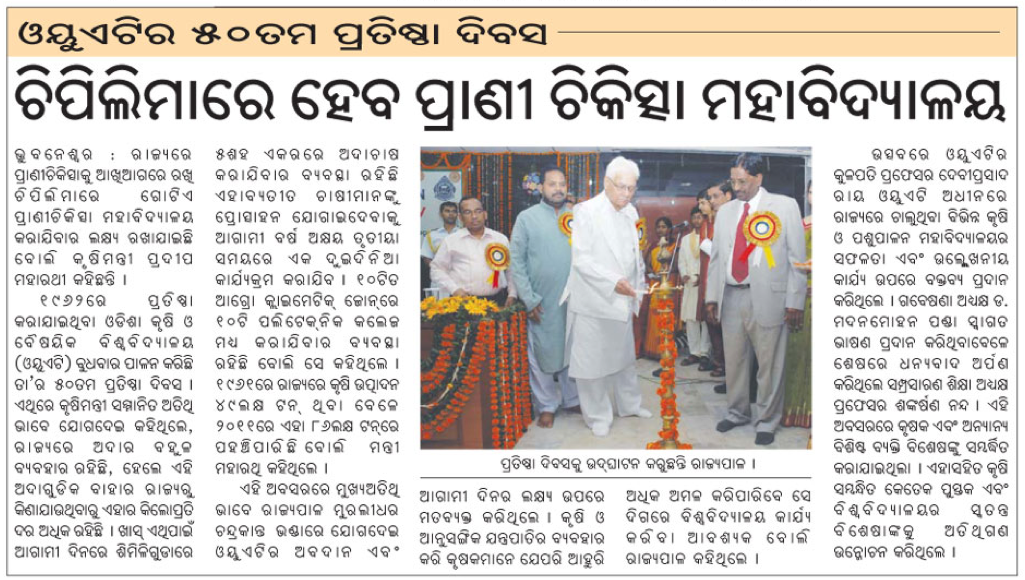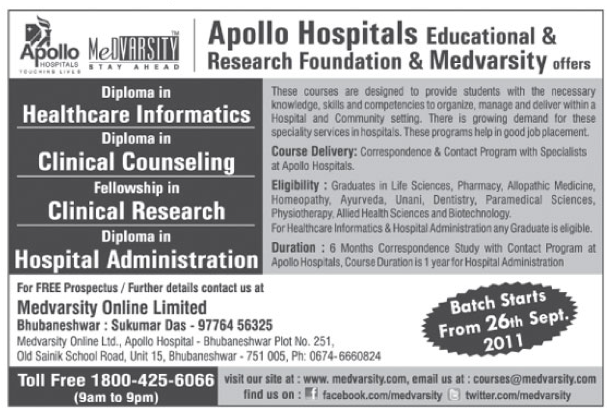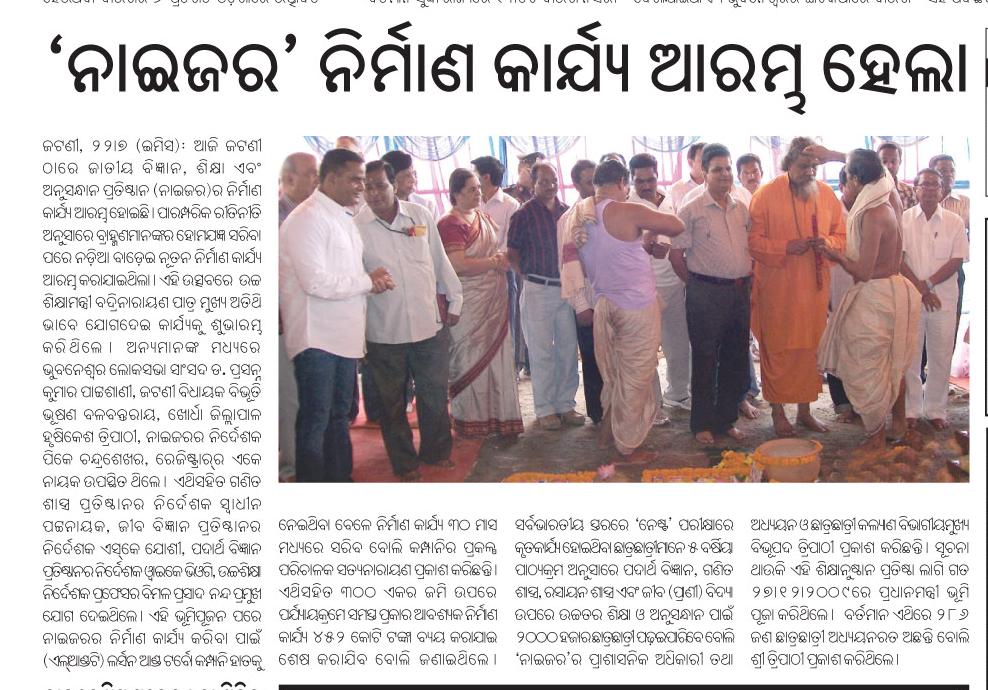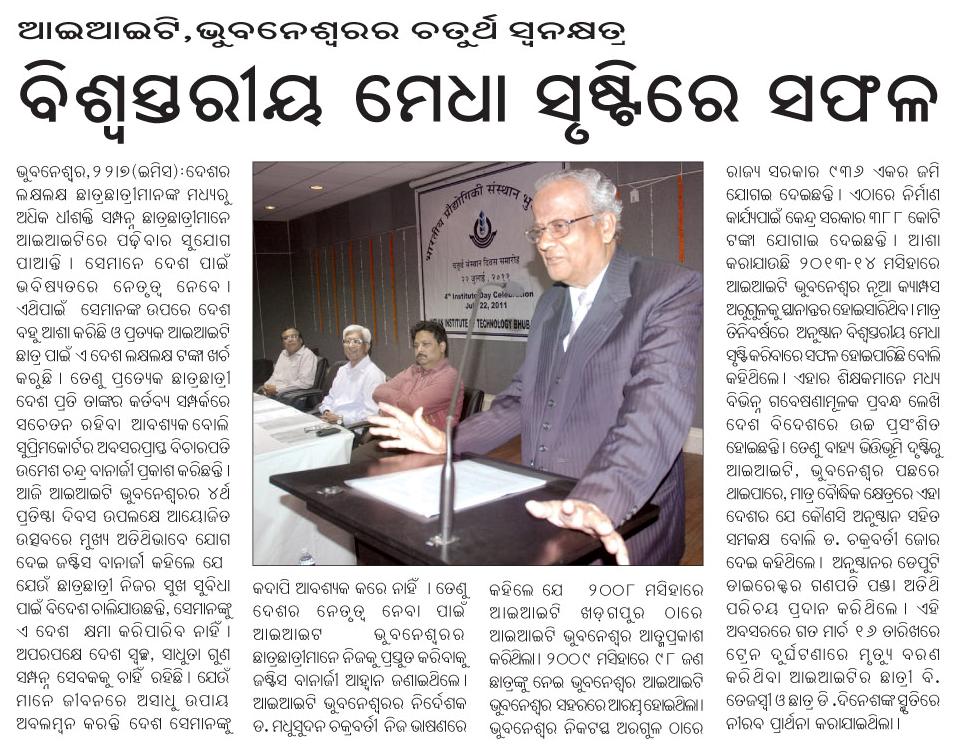Update: As per this news report the 6 new AIIMS-like institutes are scheduled to start the medical colleges from academic year 2012-13 and hospitals in the year 2013-14.
Following is from a report in Times of India.
With the beginning of construction work of IIT Bhubaneswar (IITBBS) campus on Sunday, work for permanent infrastructure of all three premier central institutes in city fell on track. While work for the campus of National Institute of Science Education and Research (NISER) here started on July 21, infrastructure for AIIMS is at an advanced stage of completion. All three institutes hope their permanent campuses to be functional by 2013.
Chief minister Naveen Patnaik inaugurated the IIT campus construction at Aragul village near Jatni on a 950 acre plot of land. IITBBS director, professor M Chakraborty, said the master plan of the campus has been designed to accommodate 10,000 students, 1,000 faculty members and 1,100 non-teaching employees, besides 1,000 out-sourced support staff. The institute also has plans to construct a research park, he said.
The first phase of work, undertaken by CPWD at an estimated Rs 800 crore, would be limited to hosting a capacity of 2,500 students, 250 faculty members and 300 other employees. Chakraborty hopes the institute will shift to its permanent campus by 2013 end or beginning of 2014.
At the already provided budget of Rs 388 crore, IITBBS would construct a main administrative building, lecture hall and classrooms, a laboratory complex, four academic schools (basic science, electrical, infrastructure and mechanical engineering), central workshop and students’ activity centre. The main building is slated to be a six-storey structure and the other schools of four storey each. The hostels as well as the residential quarters are to be seven-storey buildings, Chakraborty said.
Apart from its city campus, the IIT would also set up an innovation centre for climate change on the Puri-Konark coastline, under the School of Earth Ocean and Climate Sciences, the director said.
Construction of the permanent campus of NISER started on a 300-acre site about a month ago, also near Jatni, on July 21. The Rs 457 crore project would include a prayer hall on the hill top, five schools of different specialties, 11 hostels of 200 capacity each, healthcare centre and guest house, said NISER registrar Abhay Naik.
Work for the AIIMS, which started on 100 acres land at Sijua village in May 2010, is at a stage of about 80% completion, sources said. The proposed 978-bed hospital, under the Pradhan Mantri Swasthya Suraksha Yojana, is supposed to have 15 super speciality and 18 speciality wards.
August 16th, 2011
Following is an excerpt from Shilp Sampad’s report in Telegraph.
The course has been approved by the State Council for Technical Education and Vocational Training and recognised by the Directorate of Technical Education and Training, Orissa. The department of food technology and biochemical engineering of Jadavpur University, Calcutta, will provide technical support.
“Earlier, sweets making formed a small part of training in food craft institutes, but this is for the first time in the country that an independent course in sweets technology has been introduced.
“Technology will be used right from making sweets to packaging and marketing to reduce cost of production,” said Prasanta Kar, founder of Bikalananda Kar Memorial Trust, which established BKITC.
Applications have already started trickling in and admission is expected to be completed by end of August. The intake capacity has been fixed at 64.
The minimum eligibility for the course is matriculation and the fee is Rs 15,000. However, the trust and the Paschimbanga Mistanna Byabasayee Samitee will also provide full scholarships to poor, meritorious students.
Kar said there are more than 500 types of Oriya sweets and the course would involve training in only 140 types, including 60 varieties from the neighbouring state of Bengal. “We have brought out books on these 140 kinds of sweets. The trainees would be taught making sweets using dairy products as well as agricultural products such as dry fruits, wheat, flour, gram flour and so on,” said Bibhuti Bhusan Patra, principal of BKITC. He added the course would also focus on sugar-free sweets.
The syllabus will cover trade theory such as preservation of food and sweets, process technology (good manufacturing practice), quality control in food processing, food microbiology and contaminants, wastewater treatment, sanitation and hygiene standards, food safety and practical-oriented training.
Talking about the employment prospects, Patra said there is a dearth of skilled labour in the confectionery industry and it would not be difficult for the trainees to secure jobs.
August 4th, 2011
Today, the 22nd July, is a very auspicious day for us. It is on this day in 2008, the society of IIT Bhubaneswar was registered. Further, the date assumes more significance as we began our academic programme from the city of Bhubaneswar for the first time on 22nd July 2009. I wish to avail this opportunity to congratulate our students, staff, officers and faculty, who all are working as a dedicated team to develop this new IIT, for successfully completing 2 years of existence in the city of Bhubaneswar.
…
Infrastructure:
Temporary Campuses
We started our journey in 2008 from the campus of IIT Kharagpur. As mentioned earlier, we commenced our operation from the city of Bhubaneswar from 22nd July 2009. Currently, we are operating from a number of campuses which include IIT Kharagpur Extension Centre, Toshali Plaza at Satyanagar and Workshop cum laboratory complex near IIT Kharagpur extension Centre. Government of Odisha provided us about one (1) acre of land on which we have already constructed a new workshop cum laboratory complex (22000 sq. meters). The Government of Odisha also provided us two towers of Toshali Bhavan which we have already renovated. In addition IIT Kharagpur has constructed a new 200 capacity Dr. A. N. Khosla Hall of Residence near the Workshop cum Laboratory Complex for the students of this Institute. I must avail this opportunity to thank IIT Kharagpur for constructing the hostel which is of great convenience to us. We are also getting support of some of the sister Institutes like IMMT (CSIR) and Central Tool Room and Training Centre.
The class rooms and the laboratories are in place in our campuses at IIT Kharagpur Extension Centre, Toshali Plaza and the New Workshop cum Laboratory Complex.
IIT Bhubaneswar is well equipped with modern Teaching rooms and Teaching and Research Laboratories. All the class rooms are fitted with Multimedia Projectors, Internet Facilities and Wireless Connectivity. Besides the Normal teaching rooms, The Institute designed and developed three Virtual Class Rooms (VCR) sponsored by National Knowledge Networks (NKN). These rooms facilitate Real time on campus and Off-campus teaching learning process. These rooms are equipped with high end and high resolution equipment to facilitate the real time interaction among the students and teachers of the campus and as well as off campus students and faculty members. These class rooms are connected to the NKN Network by means of a dedicated 1GBPS Leased Lines.
The Government of Odisha has provided us 14 flats at Government Colony, Gajapati Nagar. We are fortunate to have found cooperation from the Housing Complex in SBI Colony Kesura wherein we have hired about 60 HIG 3 bed-roomed flats and few MIG flats for accommodation of our students and faculty. While the 3rd and 4th year male students have been being accommodated in the A. N. Khosla Hall of Residence, we have to accommodate others (all the girl students, research scholars and 1st and 2nd year students) in SBI Colony Kesura, 10 KM away from our academic campus. I may avail this opportunity to put on records my deep appreciation of the students, the staff and faculty who have to commute regularly between their residence and the various academic campuses. I am aware that this is strenuous. But I am sure our students, faculty and staff will accommodate the strains and be a part of the history in the making.
Permanent campus
The Foundation Stone of our campus at Arugul was laid on 12th February 2009. The Government of Odisha has allotted 936 acres of land at Arugul (near Jatni) for developing this new IIT of which we already have taken advanced possession of 598 acres. The Government of Odisha has started construction of 4 lane access road to IIT Campus from the National Highway 5. The work on water supply and electric supply to the campus is also in progress. The power supply systems for construction are virtually ready. The Honourable Chief Minister himself as well as the Chief Secretary of the Sate are taking active interests in the developmental work and are addressing issues that need their constant attention. It may not be out of place to mention that the Government of Odisha has also agreed to provide us 75 acres of land on Puri–Konark coast to set up an Innovation Centre for Climate Change.
Out of total 19 KM, we already have completed construction of 8 Km of boundary wall. About 10 bore wells have been sunk to facilitate construction work. IIT Bhubaneswar has also taken up tree plantation programme for its new campus.
The master plan of the new campus at Arugul for 10, 000 students, 1000 faculty and 1100 supporting staff has been approved and the total construction should be completed in 3 phases in next 12-15 years. The work for land grading, road and other related construction are expected to begin in August 2011. While the Government of India has approved construction of 2, 21,000 sq meter of covered area in the 1st phase, our consultant has already completed conceptual design of 1, 20, 000 sq meters of covered areas for various schools, residential quarters, hostels and other service/administrative buildings based on the availability of fund in the initial phase. Applications for clearance form statutory bodies (e.g. forest, BDA, environment) are under process and such clearance are expected shortly. We expect the tendering process to be over and hope that CPWD would be able to start the construction work by the end of this year or early next year. We are planning to move to our new campus by end 2013 or beginning 2014.
Academics
Academic Schools
IIT Bhubaneswar promotes a borderless academic environment: We have the concept of Schools, rather than Departments. We encourage academic staff and students to work together in an interdisciplinary environment. Initially we had set up the following five (5) schools:
• School of Basic Sciences (Physics, Chemistry, Bioscience, Mathematics)
• School of Humanities, Social Sciences and Management
• School of Mechanical Sciences (Mechanical, Manufacturing & Industrial Engineering, Aerospace Engineering, Naval Architecture)
• School of Infrastructure (Civil Engineering, Architecture, Urban Design, Town Planning, Traffic & Transportation Engineering)
• School of Electrical Sciences (Electrical Engineering, Electronics Communication Engineering, Computer Science and Engineering, Energy, Learning Sciences, Instrumentation)
The Institute has just set up the following two (2) new Schools:
• School of Mineral, Metallurgical and Materials Engineering – Materials, Metallurgy, Mining (Relevant to the Rich Resources of metals and minerals in the region)
• School of Earth Ocean and Climate Sciences (Relevant to the region keeping in view the vast Coast Line, Rich Biodiversity and mineral resources, need for Disaster Management and Mitigation arising out of Flood, Cyclone etc.) As a part of this School, the Institute will set up an Innovation Centre for Climate Change on the Puri-Konark coast line.
The following schools are proposed to be set up in the second phase of our expansion:
•School of Chemical and Biochemical Engineering Chemical, biochemical, biomedical, biotechnology
• School of Design and Creative Arts
Academic Activities
We started our journey with a total of 94 students in three (3) undergraduate programmes namely civil, electrical and mechanical engineering with an intake capacity of 40 each in 2008. We already have introduced Ph. D. programmes from 2009 and have about 35 Research Scholars. We are planning to start our postgraduate (MS/M. Tech.) programmes from July 2012. Currently, we have about 500 students (UG and Ph. D.), 50 full time faculty members 7 officers and 40 supporting staff.
Awards and Honours
We are proud that our Chairman Board of Governors, Professor P. Rama Rao, has received the second highest civilian award “Padma Vibhushan” of the Government of India this year.
Prof. S. C. Datta of the School of Infrastructure was awarded Fulbright-Nehru Sr. Research Fellowship and he visited the University of California at Davies, USA. He has been awarded the prestigious Occasional Lecturer Fund by Council for International Exchange of Scholars, US Department of State, for delivering two invited lectures at University of Massachusetts, Dartmouth, during his Fulbright Grant period in USA. Dr. Sumanta Haldar of the same School received the Prof. Leonard’s best Ph.D. thesis award from Indian Geotechnical Society. Dr. C.S. Bhende of the School of Electrical Science received the best Ph.D. thesis award from Indian National Academy of Engineering.
Mr. Pyari Mohan Pradhan, Mrt. Satyasai Jagannath Nanda and Mr. Vikas Baghel, Research Scholars of the School Electrical Sciences were awarded the Department of Foreign Affairs and International Trade, Government of Canada, “Commonwealth Graduate Student Exchange Programme” fellowship. Dr. Subhransu R. Samantaray of the same School won the Samanta Chandra Sekhar Award for 2010 from Orissa Bigyan Academy for his contribution to Engineering and Technology by Oriya Scientist working in Odisha. Dr D. Sahoo of Humanities, Social Sciences and Management received the Best Paper Award at the International Workshop on Regional Competitiveness and International factors Mobility at Oriens France. Professor M. Chakraborty received the Best Technical Paper Award 2010 from the Indian Foundry Journal of the Institute of Indian Foundrymen.
Mr. Raghav. R, 3rd Year Student of Mechanical Engineering won the All India essay competition for college students conducted by the NGO: Nandini Voice for the Deprived
Publications
Within 2 years of our existence in the city of Bhubaneswar, the faculty members have already contributed to creating new knowledge by publishing about 115 papers in National and International Journals of repute. Besides, 85 papers have been presented in various National and International Conferences in India and Abroad that have made our presence felt all over the world. Our doctoral and undergraduate students have also published a few papers in journals and made presentations in conferences. Our faculty members have also published 17 books/ chapters of books in Humanities, Science and Technology.
Sponsored Projects and Consultancy and Endowment
The Institute already has received a number of sponsored projects from various funding agencies like DST, CSIR and DRDO and consultancy from industries worth more than 320 lakhs.
Industries are coming forward to join us in developing this new IIT. M/s MGM Minerals Group has already established a perpetual “MGM Chair Professor” for the School of Minerals, Metallurgical and Materials Engineering with an endowment of Rs 300 lakhs.
International Collaborations
IIT Bhubaneswar has started collaborative activities with a few Universities abroad. We already have signed MOU for faculty exchange programmes with the University fo Massachusetts at Dartmouth USA, and the University of Western Ontario Canada. Professor Lord S. Kumar Bhattacharyya of the Warwick Manufacturing Group, of the University of Warwick has been appointed as Distinguished Visiting Professor of IIT Bhubaneswar while Professor Richard Dashwood of the same university spent two weeks at IIT Bhubaneswar as visiting Professor in March 2011. Professor Asit K Biswas, President of the Third World Centre for Water Management, Winner of Stockholm Water Prize (2006) has also been appointed as Distinguished Visiting Professor of this Institute.
Workshop/Conferences
The Institute organized a one day workshop “An Academy – Industry Interface” with participation from the Warwick Manufacturing Group, the University of Warwick, UK, IIT Bhubaneswar, Tata Steel, Infosys, IBM, WIPRO, L&T and others on 17th September 2010. Another workshop “Multivariate Statistical Analysis” was organized by the School of Humanities, Social Science and Management on 24th March 2011. The Training and Placement Section had organized a Panel Discussion “Managing Generation Y in workplace – A Challenge to the Indian Industry” on 12th March 2011. The Institute has started organizing “Research Scholars Day” on the National Science Day on 28th February every year.
Summer Internships
Our students have received support from various Universities and Industries in India and Abroad for summer internships. Some of these Universities and Industries abroad are the University of North Texas, Oklahoma State University, University of Massachusetts at Dartmouth, Northern Arizona University in USA, University of Warwick UK, McGill University Canada, University of Cologne Germany, University of Padua Italy, Flanders Mechatronics Centre Belgium, ExTechNa GmbH Switzerland, University of Zacadecas Mexico, Tianjin University China, Ming Chi University Taiwan and University of Technology Malaysia.
… Student Activities
Our Students under the Students Gymkhana are quite active and are organizing various activities. They already have formed several societies like Robotics Society, Entrepreneurship Cell, Dramatic Society, Music Society to name a few. They have been organizing cultural (Alma Fiesta) and Techno-Management (Wiessenaire) festivals successfully with support from many sponsors/industries drawing participations from various colleges/institutions of the country.
July 28th, 2011
Following are excerpts from Shilpi Sampad’s report in Telegraph.
Institute: The Government Aviation Training Institute, popularly known as Gati, is the only pilot training institute in the state, which is run by the government. It is located on the premises of Biju Patnaik Airport, Bhubaneswar.
Course: It offers two programmes – Private Pilot License and Commercial Pilot License, and runs three batches per year with a maximum of 30 trainees in each batch. The next batch starts from October. Interested candidates can start applying.
Important: A medical fitness certificate from a director general civil aviation (DGCA)-approved doctor is mandatory for admission.
Private Pilot License (PPL): It is a six-month course and the fee is nearly Rs 6 lakh. The minimum qualification is matriculation. PPL involves 50 hours of flying.
Commercial Pilot License (CPL): The course lasts for 18 to 22 months and costs around Rs 19 lakh. The minimum eligibility is Plus Two with pass marks in physics and mathematics. Aspirants from non-science background can take provisional admission and appear for the two subjects through open school exam. CPL involves 200 hours of flying.
Common features: For both courses, 350 hours of compulsory ground classes precede the flying. The classes include theoretical lessons in air regulation, air navigation, aviation meteorology, technical general and technical specific. After attending the required hours of ground classes, a trainee earns a Student Pilot License (SPL) and Flight Radio Telephony Operating License (FRTOL) for solo flying. Candidates, who wish to attend only these classes and pursue flying at any other institute, have to pay a course fee of Rs 1.35 lakh.
Flying training: There are four aircraft – two each of Cessna 152 (two-seater) and Cessna 172 (four-seater). There are three runways for flying operations in Bhubaneswar, Hirakud (Sambalpur) and Gopalpur (Ganjam).
Reservation: Applicants belonging to SC/ST categories can avail 100 per cent scholarships provided by the central government. Fifty per cent seats are reserved for domicile candidates but the share of students from the state is low. …
Loan and accommodation: Applicants can avail bank loans easily for studying at Gati. The academy also helps the pilot trainees find accommodation in nearby areas.
Scope: After completing the course, one has plenty of opportunities at hand to get employed in the areas of airlines, corporate charters, coast guard, paramilitary, state government / public sector units and so on. To add to their experience, they can become instructors at flying schools. Those who have done the private pilot license course can fly privately owned aircraft. The institute is also in touch with several corporate houses for placement opportunities.
The highlighted part should be publicized in places like KISS so that many of the students there are aware of this option.
July 24th, 2011



